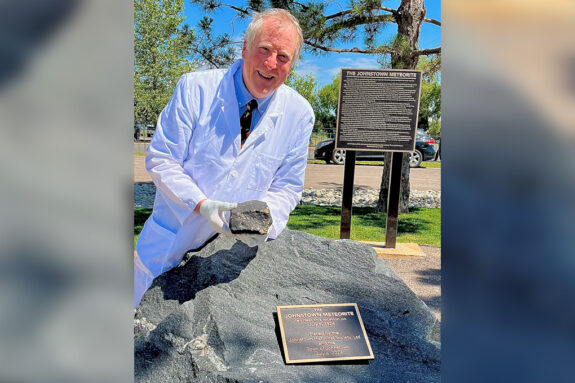Kalina Grabb studies some of the ocean’s most reactive chemicals

Kalina Grabb is a marine geochemist and MIT-WHOI Joint Program student, specializing in the study of reactive oxygen species (ROS) in the ocean. An alumna of Harvard University, Grabb spent her formative years researching the lifecycle of sulfur, nitrogen and oxygen in the ocean system. After graduating, she was awarded a Fulbright Fellowship and conducted independent research at the Ocean University of China in Qingdao, where she studied nitrogen cycling within the Yangtze River. She is now a member of Colleen Hansel’s microbial geochemistry lab, where she has played an integral role in the development of DISCO, or Diver-operated Submersible Chemiluminescent sensOr, which performs in situ measurements of volatile chemicals produced in marine ecosystems.
Read this at Woods Hole Oceanographic Institution
You’ve spent a good deal of your time at WHOI studying highly reactive superoxide. What is this chemical and why is it so important to study it?
Superoxide is a type of reactive oxygen species (ROS), which comprises short-lived oxygen-containing molecules that play essential roles in the health and biogeochemistry of the ocean.
They are produced and destroyed by any organism that utilizes oxygen––including us! When they build up inside of humans, they can lead to oxidative stress and can be linked to cancer, heart disease, aging, and many other detrimental health conditions. This is why we are encouraged to eat antioxidants, such as blueberries and dark chocolate. However, while we traditionally think of ROS as having negative impacts, more recent evidence indicates that ROS is also vital for some essential biological processes. At the right concentrations, ROS can help with cell signaling, growth regulation, fending off pathogens, and more. The balance of ROS within an organism is similar to a “Goldie Locks” effect. If you have too much, it is harmful; if you have too little, some essential biological functions fail.
We have known that ROS plays a vital role in the health of other marine organisms, however, it wasn’t until a few years ago that we discovered that coral reefs were associated with extremely high concentrations of superoxide. In the dire state of coral reefs today, it is extremely important to understand how this chemical affects their health. Superoxide may be playing an unrecognized, yet critical role.
You’re a part of WHOI’s Broader Impacts Group (BIG), where you’ve sought to educate others about coral conservation. What knowledge do you try to impart through outreach?
I like to educate people about the beauty, vitality, and vulnerability of coral reef environments. I hope others learn to care for our coral reefs, which can inspire them to make small changes to help sustain ocean life, protect our coastlines, and preserve their beauty.
I feel really lucky to have found my passion through ocean science, so I want to inspire younger generations from all backgrounds to discover their passion. Not everyone has the chance to be acquainted with the ocean, so it is extremely important to access diverse populations and share with them a small part of what we know and what we study.

Kalina Grabb hovers over a reef in the U.S. Virgin Islands, using DISCO to sample fast evaporating superoxide. (Photo: Cynthia Becker, © Woods Hole Oceanographic Institution)
With the advent of technologies like DISCO, how do you think your field will change in the next decade?
DISCO is just one example of technologies that are increasing our capacity to collect in situ measurements in novel ways. But it’s also non-invasive, which means we can use it without disturbing the reef ecosystem. The real-time data collection assists in previewing the superoxide concentrations during collection so that we can amend our surveys based on current observations. While these are only a few features of DISCO, overall advancement in technology within the field of oceanography is allowing scientists to ask and answer questions that they could not before.
While there are many new instruments being developed in the field, DISCO, in particular, could continue to increase the sampling capabilities that allow us to better understand organisms in their natural environment.
What made you choose to study at Woods Hole Oceanographic Institution?
As a perspective student, I was interested in being surrounded by cutting edge ocean research, but what I really underestimated was the importance of the people. In particular, I feel privileged to work on this project and with my advisor, Colleen Hansel, whom I really admire both as a scientist and as a person. I am constantly impressed by the innovative way that she approaches scientific questions that leads us to explore questions from unique angles. She is a great role model for how to be an incredible scientist while also balancing family life.
As a whole, WHOI happens to have some of the world’s leading experts in a wide range of disciplines, so it is easy to gain insight into tangential areas of study and discuss with others potential ways to collaborate. People here are readily willing to help and explain things so that others can understand.
Since the beginning, I always felt WHOI scientists valued students’ opinions and treated us more as peers rather than pupils. Here, I feel I’ve been in a nurturing environment that allows me to grow as a scientist, yet one that also pushes me to learn skills that I did not think were possible. I am extremely thankful to be a part of this community.
Story Image: MIT-WHOI Joint Program student, Kalina Grabb, works with a portable measurement system, DISCO, to discern the levels of highly reactive chemical agents that exist in the water column, namely superoxides. (Photo: Daniel Hentz, © Woods Hole Oceanographic Institution)


